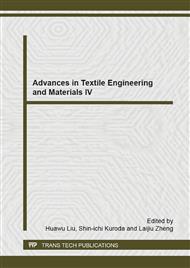p.13
p.17
p.21
p.26
p.31
p.36
p.41
p.46
p.52
Evaluate on the Alkaline Resistance Properties of Bio-Based Nylon 56 Fiber Compared with the Normal Nylon Fiber
Abstract:
The new kind of bio-based nylon 56 fiber has been synthesized by adipic acid and 1,5-pentanediamine, which was prepared by fermenting a variety of starch in straw. The resistance of the nylon 56 fiber to acid need to be evaluated because the problem of nylon fabrics often encounter reactions of chemical reagents in their processing, finishing and dressing. Temperature and concentration play the main role on the alkali resistance among the factors that influence alkali resistant of nylon fibers: temperature, time, and concentration of alkali. Strength lose of bio-based nylon 56 and nylon 6 are slightly larger than that of nylon 66 when treated in caustic soda of 100 g/L at 98°C for 120 minutes, which means that nylon 56 fiber have good alkali resistant.
Info:
Periodical:
Pages:
31-35
Citation:
Online since:
October 2014
Authors:
Keywords:
Price:
Сopyright:
© 2014 Trans Tech Publications Ltd. All Rights Reserved
Share:
Citation:


